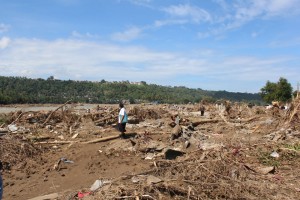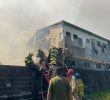 Extreme weather made worse by unchecked mining and logging projects in the watersheds of Northern Mindanao have rendered thousands homeless in the aftermath of Typhoon Sendong.
Extreme weather made worse by unchecked mining and logging projects in the watersheds of Northern Mindanao have rendered thousands homeless in the aftermath of Typhoon Sendong.
By LOUISE DUMAS
Davao Today
CAGAYAN DE ORO CITY, Philippines — “We only need a cooking pot as someone already gave us a mat and a blanket,” said Rosalina Angkod, resident of the entirely washed-out community of Kala-kala, Brgy. Macasandig, one of the 23 villages in the city badly hit by typhoon Washi (local name: Sendong). Used to a hard life of scavenging and selling junk scraps, a pot was all Angkod, 65, wished for Christmas.
Other residents wished for more than the pot. To date, government and nongovernment sources have pegged more than a half a million people in the four Philippine provinces affected with the typhoon, while deaths and the missing reached a staggering 1,342. Residents like Angkod and her family of six camped outside the village hall of Macasandig, one of the17 evacuation centers manned by local authorities after typhoon Sendong hit the city on December 17. More than a thousand families marked the Christmas holidays at the evacuation centers, according to the National Disaster Risk Reduction Management Council (NDRRMC), while the nongovernmental Rural Missionaries of the Philippines (RMP) put the total affected families at 45,009, who mostly made do with shanties in nearby communities.
The night before typhoon Sendong struck, village officials went around warning people. “I had already instructed everyone in my family to be alert that night,” Angkod said. “The moment the water started to rise to our knees, we immediately headed out. We were able to bring only an umbrella but we are thankful that we all survived.” Many of her neighbors drowned in their sleep as the water rose fast.
Sendong was the first storm to hit the city in the recent years and one of the deadliest calamities to hit the country. To date, its damage has reached almost PhP 1 billion affecting infrastructures and agriculture, among others.
It was not simply because too much water came in too short a time, as environment authorities would have it. “The tragedy was due to bad decisions. It was a natural calamity, aggravated by the bad policies from both local and national governments,” said Vanessa Entia, Deputy Secretary General of Bayan-Northern Mindanao. The watershed of the Cagayan de Oro river has been ravaged by logging and mining operations. At least four Exploration Permits and three Mineral Production Sharing Agreements have been issued in the Western part of Misamis Oriental to Iligan City, on top of the illegal hydraulic mining operations at the head river of Iponan in Opol. Entia added that near the Cagayan de Oro river tributaries in Bukidnon, the natural forests have also been replaced by pineapple and banana plantations.
When he visited the city three days after Sendong struck, Philippine President Benigno Aquino III promised a thousand houses for the victims, on the condition that no one will be allowed back to the areas identified as critical. The number of housing units up for grabs, however, could not even accommodate half of the families whose houses were completely washed out by the floods. Based on NDRRMC data, there are 5,801 houses that were totally damaged. Pres. Aquino practically blamed affected residents for living in flood-risk areas as identified through the geo-hazard mapping. Residents who live in these areas comprised the urban poor communities who can ill-afford to relocate to safer places.
Entia said the downstream areas of the river are critical but the government has not provided alternatives for the communities. Families have been risking floods because they have no option and have gotten accustomed to leaving their homes every time flood strikes. “If we look at the entire map of the city, viable residential areas are allocated for exclusive subdivisions, industries and commercial establishments,” Entia added.
Pres. Aquino ordered Php 450 million for the core shelter program of Typhoon Sendong victims in Cagayan de Oro and Iligan City. But the financial allocation is a bit too late, considering that as early as when he went into office, Pres. Aquino was already apprised that 66 out of 80 provinces were considered at risk during typhoons. Cagayan de Oro and Iligan cities are among the 25 “vulnerable climate hotspots” in the country based on a simulation done in 2009 by convenors of the Philippine Imperative on Climate Change. These “hotspots” are said to be prone to storm surges and flooding and where impacts on climate change are high. Although Pres. Aquino ordered a total log ban, the directive was again too late, as a carpet of floating logs coming from Lanao and Bukidnon forests swept Iligan down to Macajalar Bay.
“It is high time that the government reconsiders its development track,” Entia said. “They have formed a task force to look into the accountability of the tragedy but we urge that they view it vis-à-vis the policies that they themselves have created,” she added.
Gabriela Cainoy, whose 4 year-old son is still missing, vowed to never return to their community located at the mouth of the river saying “Who would want to go back when many of us have lost a family member?”
But for the elderly Rosaline Angkod, “We have nowhere else to go. I would prefer to be relocated to a far but secure place, but I cannot say the same for my children who live off on odd jobs to earn barely enough.” (Louise Dumas/davaotoday.com)
cagayan de oro, climate change, climate justice, emano, environment, flash flood, floods, sendong









